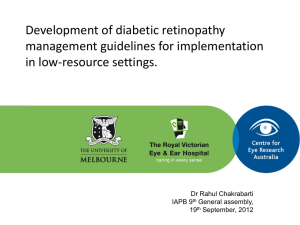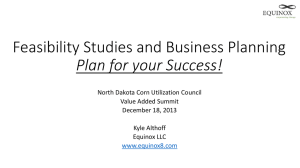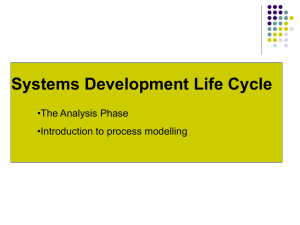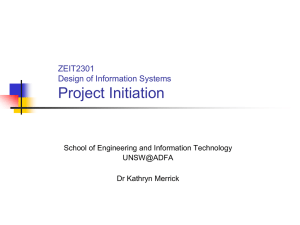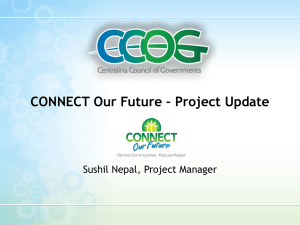Developing Feasibility Studies and Business Plans
advertisement
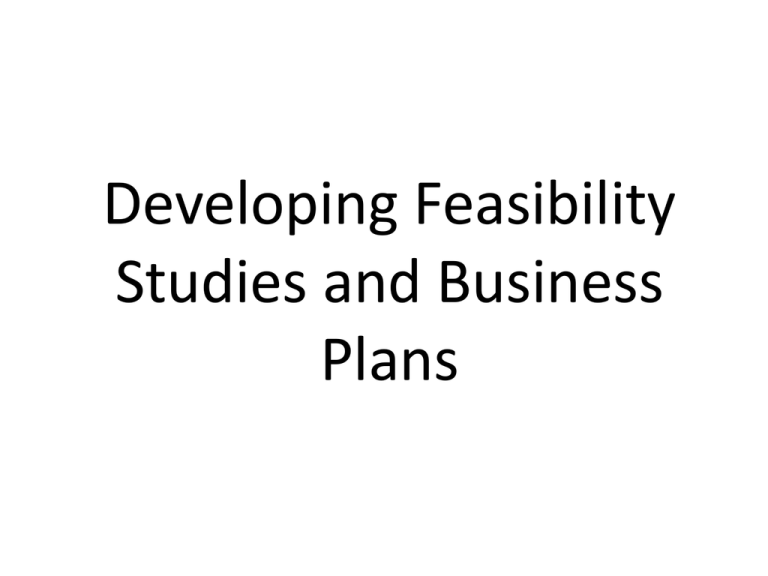
Developing Feasibility Studies and Business Plans Points to be Pondered… • • • • What is a Feasibility Study? What is a Business Plan? How do they differ? What Resources are available to help develop each? – Are all Studies created Equal? What is a Feasibility Study? • A feasibility study is an analysis of the viability of an idea through a disciplined and documented process of thinking through the idea from its logical beginning to its logical end. • A feasibility study provides an Investigating function that helps answer “Should we proceed with the proposed project idea? Is it a viable business venture?” • A feasibility study should be conducted to determine the viability of an idea BEFORE proceeding with the development of a business. Levels of Feasibility Assessment • A feasibility study of an idea is conducted at three levels – Operational Feasibility (Market) • “Will it work?” – Technical Feasibility (Technical) • “Can it be built?” – Economic Feasibility (Financial) • “Will it make economic sense if it works and is built?” • “ Will it generate PROFITS?” Why do a Feasibility Study? • Provide a thorough examination of all issues and assessment of probability of business success • Give focus to the project and outline alternatives • Narrow business alternatives • Surface new opportunities through the investigative process • Identify reasons NOT to proceed • Enhance the probability of success by addressing and mitigating factors early on that could affect the project • Provide quality information for decision making • Help to increase investment in the company • Provide documentation that the business venture was thoroughly investigated • Help in securing funding from lending institutions and other monetary sources Data Sources for a Feasibility Assessment • Data required for a feasibility study can come from primary or secondary sources – Primary data can include formal interviews and surveys • Collection of primary data can be expensive and time consuming – Secondary data can include industry and trade publications, statistics of industry associations, and government agency reports Steps for an Economic Feasibility Study • Identify and Estimate all Capital Expenditures • Identify and Estimate all Variable Costs related to the Proposed Business Venture – Identify People and Skills required to operate • Determine Wages, Salaries, and Benefits • Identify and Estimate Project Related Costs – – – – Infrastructure development or improvements Advertising and Promotion Legal Fees Municipal & State Development taxes • Identify and Estimate all Fixed Costs Estimating Total Capital Requirements – Assess the “seed capital” needs of the business project and how these needs will be met – Estimate capital requirements for facilities, equipment and inventories – Replacement capital requirements and timing for facilities and equipment – Estimate working capital needs – Estimate start-up capital needs until revenues are realized at full capacity – Estimate contingency capital needs (constructions delays, technology malfunction, market access delays, etc.) – Estimate other capital needs Equity and Credit • Estimate Equity and Credit Needs – Identify alternative equity sources and capital availability • Producers, Local Investors, Angel Investors, Venture Capitalists – Identify and assess alternative credit sources • Banks, Government (direct loans or loan guarantees), Grants, Local and State Economic Development Incentives – Assess expected financing needs and alternative sources • Interest Rates, Terms, Conditions, Covenants, Liens, Etc. – Debt to Equity Levels Cost-Benefit Analysis Utilize data collected to determine economic feasibility: • • • • • • • • • Estimate Expected Costs and Revenue Estimate the Profit Margin and Expected Net Profit Estimate the sales or usage needed to break-even Estimate the returns under various production, price and sales levels to create a “sensitivity analysis” Assess the reliability of the underlying assumptions of the financial analysis Benchmark against industry averages and/or competitors Identify limitations or constraints of the economic analysis Project expected cash flow during the start-up period Project income statement, balance sheet when reaching fullEXPENSE operation REVENUE What Defines Feasibility? • A feasible business venture is one where – the business will generate adequate cash flow and profits, – the business will withstand the risks it will encounter, – the business will remain viable in the long-term, and – the business will meet the goals of the founders. MARKETIG ANALYSIS: The marketing analysis will include: •Strategic marketing: Reviewing the enterprise’s business strategies and it related marketing strategic intent if exist. •Marketing functions attributes: assessing the existing marketing function structure, operations, people ...etc. •Markets analysis attributes: Conducting an overview of the international and national markets of the enterprise and conducting a market analysis for its major products, competitors, suppliers and customers. •Market size, sales volume and company’s share attributes: Determining market shares, growth rates, trends, market requirements, etc. and analyzing the turnover (per product, year, local, export…),, sales volumes, value in JD, and percentage of the products marketed and their progress. •Marketing Mix (4Ps) attributes: Assessing marketing performance and conducting product, pricing, promotion and distribution (place) mix analysis. 1.Products attributes: Analyzing the enterprise’s market products product range/mix. 2.Advertising and Promotion: assessing the current tools and techniques for promotion and advertising. 3.Pricing: reviewing the current pricing policy. 4.Distribution (place): assessing distribution channels and communication policies. •Customers attributes: identifying the current and potential customers and identifying their characteristics. •Competitiveness attributes: identifying major competitiveness factors (including, but not limited to, manpower, technology, delivery conditions, design, procurement and marketing) •Benchmarking attributes: Conducting a benchmarking analysis based on benchmarking factors for each product range, market segmentation (designer labels, expensive brands, average prices, medium quality, low prices-low quality, etc) TECHNICAL Analysis: The Technical Audit will include: •Products technical attributes: identifying all types of products, characteristics, types and use. •Materials attributes: Analyzing the current types of products and their materials, their characteristics and sources. •Processes attributes: assessing the current technologies, processes, fabrications, tools, and techniques for producing the products. •Factory premises attributes: assessing the availability of space required for production, storage, maintenance and utilities. •Factory layout attributes: assessing the current layout status and its relationship with the handling system and the work station organization. •Machines attributes: identifying the nominal and actual capacity, age, and trade mark of each machine in the company. •Productivity attributes: the productivity level within the company compared to its competitors. •Production planning and control attributes: assessing the existing system used for production planning and control and operations management system components. •Safety and Maintenance attributes: identifying the used safety policies, preventive vs. corrective maintenance activities and policies. •R&D attributes: assessing the existing R & D activities and areas of concern. •Procurement and inventories attributes: identifying the current inventories policies, inventory management system characteristics, Procurement procedures and suppliers relationships. •Logistics and materials management attributes: evaluating the existing materials management and logistics system and its network. •QM attributes: assessing the existing quality control, assurance and management system. •Cost analysis attributes: analyzing the operational cost and costing system. •Environment/Energy attributes: assessing the current activities for environment and energy protection and concerns. FINANCIAL Analysis: The Financial Diagnostic will include: •Financial management system attributes: assessing the current financial system structure, components, resources, procedures and staff. •Accounting system attributes: evaluating the current accounting system and the used procedures. •Financial statements attributes: analyzing the existing income, balance sheet and cash flow statements. •Debt attributes: identifying the company’s current debt status and repayment schedule and related collateral, for the last five years (if exist). •Ratios analysis attributes: analyzing the financial situation of the enterprise through conducting the following analysis by ratios: •The analysis of assets and liabilities structure •The cost and expenses breakdown analysis of manufacturing, general & administrative, sales & marketing, etc. •The value added analysis •The working capital analysis •The liquidity ratios •The activity ratios •The debt (leverage) ratios •The profitability ratios. •Financial restructuring attributes: formulating a plan, if needed, to ensure proper cash flow management. What Next? • After the feasibility study has been completed and presented to the leaders of the project, they should carefully study and analyze the conclusions and underlying assumptions • Next they will decide which course of action to pursue – Potential Courses of action include • Choosing the most viable business model, developing a business plan and proceeding with creating and operating a business • Identifying additional scenarios for further study • Deciding that a viable business opportunity is not available and moving to end the business assessment process • Following another course of action Developing a Business Plan What is a Business Plan? • A Business Plan summarizes the plan of action after a course of action has been determined through the Feasibility Study • A Business Plan provides a Planning function • A Business Plan outlines the actions needed to take the proposal from “idea” to “reality” • A Business Plan tells How your business will be created and Why it will be successful ?? • A Business Plan provides a road map for strategic planning Why Write a Business Plan? • Put the Pieces Together—Do the pieces fit together in a logical manner? • Create a Blueprint for Action • Focus Founders and/or Management Team • Obtain Financing • Attract Equity Investment • Attract Key Managers and Employees • Obtain Contracts • Create Joint Ventures, Mergers, Acquisitions What is included in a Business Plan? • A Business Plan should be brief, concise & straight to the point • Main Requirements May Include – – – – – – – – – – Industry Description Market Size Customer Base Competitive Advantage Business Location Three years of Financial Projections Monthly Tracking of First Year Financials Management Experience and Profile Personal Statement of Affairs Other Sources of Cash, if any How Effective Is the Business Plan? • How effective a Business Plan is depends on how well the following questions are answered: – – – – – – – – – – Who are we? What do we do? What do we have to offer? Why will someone pay for our products/service? What resources do we have? Where are we going? What do we need to get there? Why will we be successful? Why should someone participate or invest? How will we measure performance? The Story a Business Plan Tells… • Business Plan should be tailored to the stakeholders • Be aware of each potential stakeholder’s priorities • Make sure all priorities are addressed in a balanced manner in the business plan • If more than one version of a business plan is written, make sure each tells the SAME story only with difference emphasis Who is the “Target” of a Business Plan? Stakeholder Issues to Emphasize Issues to Deemphasize Banker Cash-Flow, Assets, Solid Growth Fast Growth, Hot Market Investor Fast Growth Potential Assets, Large Market, Management Team Strategic Partner Synergy, Proprietary Sales Force, Assets, Products Large Customers Stability, Service Fast Growth, Hot Market Key Employees Security, Opportunity Technology Merger & Acquisition Specialist Past Accomplishments Future Outlook *Portable MBA for Entrepreneurship, William B. Bygrave, John Wiley & Son, Inc., 1994 Feasibility Study vs. Business Plan • Feasibility study answers the bottom line question—Is this venture going to make money? • Feasibility study outlines and analyzes several alternatives or methods of achieving business success • Feasibility study is conducted before a business plan • Business plan is prepared only after the venture has been deemed to be feasible • Business plan deals with only one alternative or scenario that is determined to be the “best” alternative • Business plan considers the management side—goals and objectives of the planned business venture What resources are available to help develop each? • Hired Business Consultants – Make sure an accurate assessment is given – Make sure someone is not paid to give the answer the group wants to hear – Can be costly • Third Party Unbiased – Universities • Center for Agribusiness & Economic Development • Small Business Development Center


